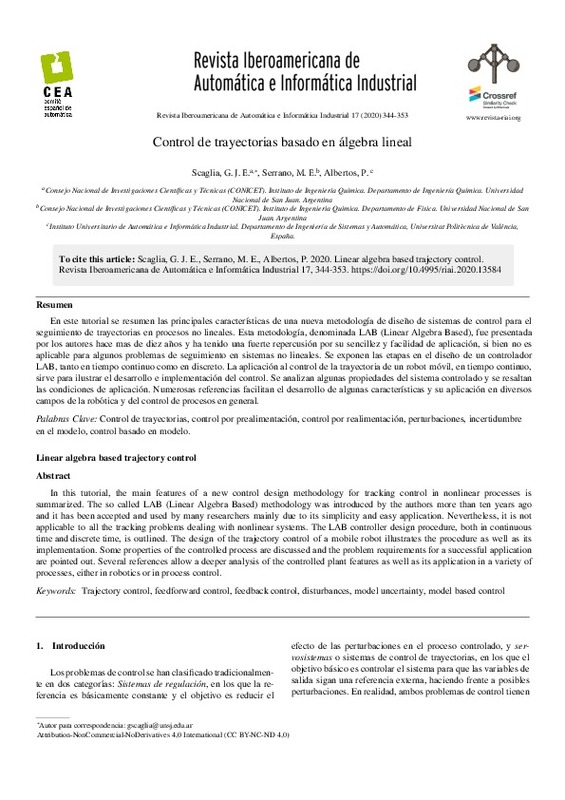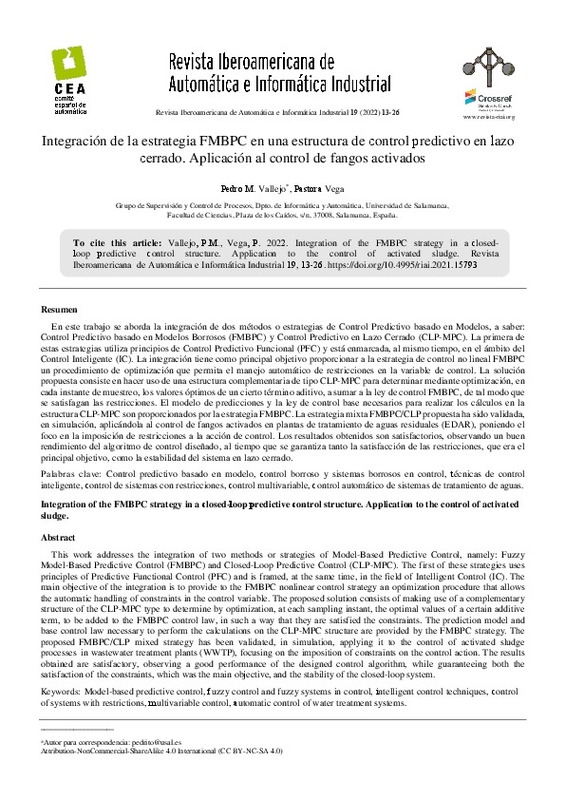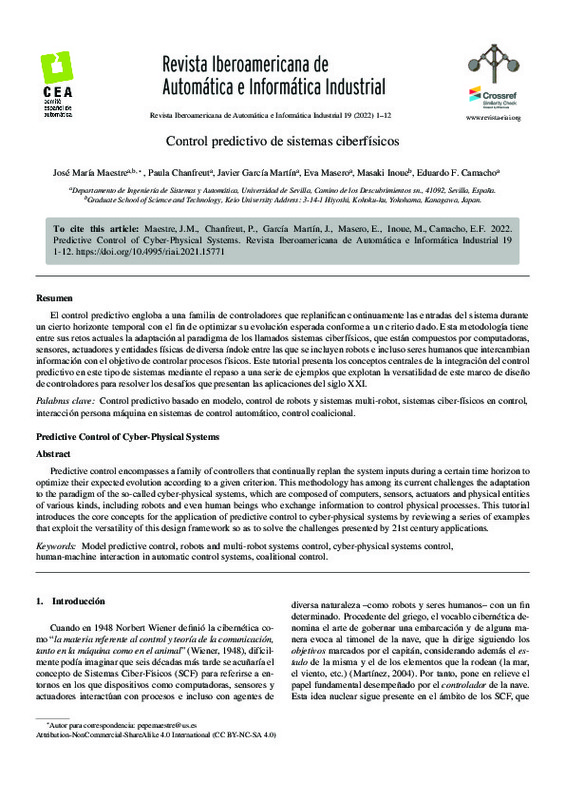JavaScript is disabled for your browser. Some features of this site may not work without it.
Buscar en RiuNet
Listar
Mi cuenta
Estadísticas
Ayuda RiuNet
Admin. UPV
Control de trayectorias basado en álgebra lineal
Mostrar el registro sencillo del ítem
Ficheros en el ítem
| dc.contributor.author | Scaglia, G. J. E.
|
es_ES |
| dc.contributor.author | Serrano, M. E.
|
es_ES |
| dc.contributor.author | Albertos Pérez, Pedro
|
es_ES |
| dc.date.accessioned | 2020-10-05T11:45:22Z | |
| dc.date.available | 2020-10-05T11:45:22Z | |
| dc.date.issued | 2020-09-30 | |
| dc.identifier.issn | 1697-7912 | |
| dc.identifier.uri | http://hdl.handle.net/10251/151137 | |
| dc.description.abstract | [ES] En este tutorial se resumen las principales características de una nueva metodología de diseño de sistemas de control para el seguimiento de trayectorias en procesos no lineales. Esta metodología, denominada LAB (Linear Algebra Based), fue presentada por los autores hace más de diez años y ha tenido una fuerte repercusión por su sencillez y facilidad de aplicación, si bien no es aplicable para algunos problemas de seguimiento en sistemas no lineales. Se exponen las etapas en el diseño de un controlador LAB, tanto en tiempo continuo como en discreto. La aplicación al control de la trayectoria de un robot móvil, en tiempo continuo, sirve para ilustrar el desarrollo e implementación del control. Se analizan algunas propiedades del sistema controlado y se resaltan las condiciones de aplicación. Numerosas referencias facilitan el desarrollo de algunas características y su aplicación en diversos campos de la robótica y del control de procesos en general. | es_ES |
| dc.description.abstract | [EN] In this tutorial, the main features of a new control design methodology for tracking control in nonlinear processes is summarized. The so called LAB (Linear Algebra Based) methodology was introduced by the authors more than ten years ago and it has been accepted and used by many researchers mainly due to its simplicity and easy application. Nevertheless, it is not applicable to all the tracking problems dealing with nonlinear systems. The LAB controller design procedure, both in continuous time and discretetime, is outlined. The design of the trajectory control of a mobile robot illustrates the procedure as well as its implementation. Some properties of the controlled process are discussed and the problem requirements for a successful application are pointed out. Several references allow a deeper analysis of the controlled plant features as well as its application in a variety of processes, either in robotics or in process control. | es_ES |
| dc.language | Español | es_ES |
| dc.publisher | Universitat Politècnica de València | es_ES |
| dc.relation.ispartof | Revista Iberoamericana de Automática e Informática industrial | es_ES |
| dc.rights | Reconocimiento - No comercial - Sin obra derivada (by-nc-nd) | es_ES |
| dc.subject | Trajectory control | es_ES |
| dc.subject | Feedforward control | es_ES |
| dc.subject | Feedback control | es_ES |
| dc.subject | Disturbances | es_ES |
| dc.subject | Model uncertainty | es_ES |
| dc.subject | Model based control | es_ES |
| dc.subject | Control de trayectorias | es_ES |
| dc.subject | Control por prealimentación | es_ES |
| dc.subject | Control por realimentación | es_ES |
| dc.subject | Perturbaciones | es_ES |
| dc.subject | Incertidumbre en el modelo | es_ES |
| dc.subject | Control basado en modelo | es_ES |
| dc.title | Control de trayectorias basado en álgebra lineal | es_ES |
| dc.title.alternative | Linear Algebra Based trajectory control | es_ES |
| dc.type | Artículo | es_ES |
| dc.identifier.doi | 10.4995/riai.2020.13584 | |
| dc.rights.accessRights | Abierto | es_ES |
| dc.contributor.affiliation | Universitat Politècnica de València. Instituto Universitario de Automática e Informática Industrial - Institut Universitari d'Automàtica i Informàtica Industrial | es_ES |
| dc.description.bibliographicCitation | Scaglia, GJE.; Serrano, ME.; Albertos Pérez, P. (2020). Control de trayectorias basado en álgebra lineal. Revista Iberoamericana de Automática e Informática industrial. 17(4):344-353. https://doi.org/10.4995/riai.2020.13584 | es_ES |
| dc.description.accrualMethod | OJS | es_ES |
| dc.relation.publisherversion | https://doi.org/10.4995/riai.2020.13584 | es_ES |
| dc.description.upvformatpinicio | 344 | es_ES |
| dc.description.upvformatpfin | 353 | es_ES |
| dc.type.version | info:eu-repo/semantics/publishedVersion | es_ES |
| dc.description.volume | 17 | es_ES |
| dc.description.issue | 4 | es_ES |
| dc.identifier.eissn | 1697-7920 | |
| dc.relation.pasarela | OJS\13584 | es_ES |
| dc.description.references | Apostol, T., 1967. CALCULUS, One -Variable Calculus, with an introduction to Linear Algebra. Blaisdell Publishing Company. | es_ES |
| dc.description.references | Battilotti, S., Califano, C., 2004. A constructive condition for dynamic feedback linearization. Systems & control letters 52(5), 329-338. https://doi.org/10.1016/j.sysconle.2004.02.009 | es_ES |
| dc.description.references | Bouhenchir, H., Cabassud, M., Le Lann, M.-V., 2006. Predictive functional control for the temperature control of a chemical batch reactor. Computers & Chemical Engineering 30 (6-7), 1141-1154. https://doi.org/10.1016/j.compchemeng.2006.02.014 | es_ES |
| dc.description.references | Brockett, R., 1965. Poles, zeros, and feedback: State space interpretation. IEEE Transactions on Automatic Control 10(2), 129-135. https://doi.org/10.1109/TAC.1965.1098118 | es_ES |
| dc.description.references | Charlet, B., Levine, J., Marino, R., 1988. Dynamic feedback linearization with application to aircraft control. Proceedings of the 27th IEEE Conference on Decision and Control, Austin, TX, USA 1, 701-705. | es_ES |
| dc.description.references | Chwa, D., 2004. Sliding-mode tracking control of nonholonomic wheeled mobile robots in polar coordinates. IEEE transactions on control systems technology 12 (4), 637-644. https://doi.org/10.1109/TCST.2004.824953 | es_ES |
| dc.description.references | den Boom, T. J. J. V., 1998. On feedback linearization in LMI-based nonlinear MPC. In Proceedings of the 1998 American Control Conference 3, 1684-1688. | es_ES |
| dc.description.references | Devasia, S., Chen, D., B., P., 1996. Nonlinear inversion-based output tracking. IEEE Transactions on Automatic Control 41(7), 930-942. https://doi.org/10.1109/9.508898 | es_ES |
| dc.description.references | Fernandez, M. C., Romoli, S., Pantano, M. N., Ortiz, O. A., Patiño, D., Scaglia,G. J., 2018. A new approach for nonlinear multivariable fed-batch bioprocess trajectory tracking control. Automatic Control and Computer Sciences 52 (1), 13-24. https://doi.org/10.3103/S0146411618010030 | es_ES |
| dc.description.references | Francis, B. A., 1977. The linear multivariable regulator problem. SIAM Journal on Control and Optimization 15(3), 486-505. https://doi.org/10.1137/0315033 | es_ES |
| dc.description.references | Fukao, T., Nakagawa, H., Adachi, N., 2000. Adaptive tracking control of a nonholonomic mobile robot. IEEE transactions on Robotics and Automation 16 (5), 609-615. https://doi.org/10.1109/70.880812 | es_ES |
| dc.description.references | Gandolfo, D., Rosales, C., Patiño, D., Scaglia, G., Jordan, M., 2014. Trajectory tracking control of a pvtol aircraft based on linear algebra theory. Asian Journal of Control 16 (6), 1849-1858. | es_ES |
| dc.description.references | https://doi.org/10.1002/asjc.819 | es_ES |
| dc.description.references | Ghandan, R., Blankenship, G. L., 1993. Adaptive approximate tracking and regulation of nonlinear systems. Proceedings of 32nd IEEE Conference on Decision and Control 1, 2654-2659. | es_ES |
| dc.description.references | Hepburn, J., Wonham, W., 1984. Error feedback and internal models on dierentiable manifolds. IEEE Transactions on Automatic Control 29(5), 397-403. https://doi.org/10.1109/TAC.1984.1103563 | es_ES |
| dc.description.references | Huang, R., Zhu, J. J., 2009. Time-varying high-gain trajectory linearization observer design. Proceedings of American Control Conference 1, 4628-4635. https://doi.org/10.1109/ACC.2009.5160252 | es_ES |
| dc.description.references | Isidori, A., Byrnes, C. I., 1990. Output regulation of nonlinear systems. IEEE transactions on Automatic Control, 35(2), 131-140. https://doi.org/10.1109/9.45168 | es_ES |
| dc.description.references | Kanayama, Y., Kimura, Y., Miyazaki, F., Noguchi, T., 1990. A stable tracking control method for an autonomous mobile robot. In: Proceedings. IEEE International Conference on Robotics and Automation. IEEE, pp. 384-389. | es_ES |
| dc.description.references | Khalil, H., 2002. Nonlinear Systems. Prentice Hall. | es_ES |
| dc.description.references | Lee, H. G., Arapostathis, A., I.Marcus, S., 2003. An algorithm for linearization of discrete-time systems via restricted dynamic feedback. In Proceedings of 42nd IEEE International Conference on Decision and Control 2, 1362-1367. | es_ES |
| dc.description.references | Levine, J., Marino, R., 1990. On dynamic feedback linearization in r/sup 4. In Proceedings 29th IEEE Conference on Decision and Control IEEE. Honolulu, Hawaii. 1, 2088-2090. https://doi.org/10.1109/CDC.1990.203992 | es_ES |
| dc.description.references | Li, X. S., Li, Y. H., Li, X., Peng, J., Li, C. X., 2012. Robust trajectory linearization control design for unmanned aerial vehicle path following. Systems Engineering and Electronics 34(4), 767-772. | es_ES |
| dc.description.references | Li, Z., Deng, J., Lu, R., Xu, Y., Bai, J., Su, C.-Y., 2015. Trajectory-tracking control of mobile robot systems incorporating neural-dynamic optimized model predictive approach. IEEE Transactions on Systems, Man, and Cybernetics: Systems 46 (6), 740-749. https://doi.org/10.1109/TSMC.2015.2465352 | es_ES |
| dc.description.references | Lustosa, L. R., Defaÿ, F., Moschetta, J. M., 2017. The feasibility issue in trajectory tracking by means of regions-of-attraction-based gain scheduling. IFAC-PapersOnLine 50(1), 11504-11508. https://doi.org/10.1016/j.ifacol.2017.08.1609 | es_ES |
| dc.description.references | Moore, J., Cory, R., Tedrake, R., 2014. Robust post-stall perching with a simple fixed-wing glider using LQR-Trees. Bioinspiration & biomimetics 9(2), 025013. https://doi.org/10.1088/1748-3182/9/2/025013 | es_ES |
| dc.description.references | Panahandeh, P., Alipour, K., Tarvirdizadeh, B., Hadi, A., 2019. A kinematic lyapunov-based controller to posture stabilization of wheeled mobile robots. Mechanical Systems and Signal Processing 134, 106319. https://doi.org/10.1016/j.ymssp.2019.106319 | es_ES |
| dc.description.references | Pantano, M. N., Fernandez, M. C., Serrano, M. E., Ortiz, O. A., Scaglia, G. J., 2018. Tracking control of optimal profiles in a nonlinear fed-catch bioprocess under parametric uncertainty and process disturbances. Industrial & Engineering Chemistry Research 57 (32), 11130-11140. https://doi.org/10.1021/acs.iecr.8b01791 | es_ES |
| dc.description.references | Pantano, M. N., Fernández, M. C., Serrano, M. E., Ortíz, O. A., Scaglia, G. J. E., 2019. Trajectory tracking controller for a nonlinear fed-batch bioprocess. Revista Ingeniería Electrónica, Automática y Comunicaciones ISSN:1815-5928 38 (1), 78. | es_ES |
| dc.description.references | Proaño, P., Capito, L., Rosales, A., Camacho, O., 2015. Sliding mode control:Implementation like pid for trajectory-tracking for mobile robots. In: 2015 Asia-Pacific Conference on Computer Aided System Engineering. IEEE, pp.220-225. https://doi.org/10.1109/APCASE.2015.46 | es_ES |
| dc.description.references | Rojas, O. J., Goodwin, G. C., 2001. Preliminary analysis of a nonlinear control scheme related to feedback linearization. In Proceedings of the 40th IEEE Conference on Decision and Control 2, 1743-1748. | es_ES |
| dc.description.references | Rosales, A., Scaglia, G., Mut, V., di Sciascio, F., 2009. Navegación de robots móviles en entornos no estructurados utilizando álgebra lineal. Revista Iberoamericana de Automática e Informática Industrial RIAI, 6(2), 79-88. https://doi.org/10.1016/S1697-7912(09)70096-2 | es_ES |
| dc.description.references | Rosales, C., Gandolfo, D., Scaglia, G., Jordan, M., Carelli, R., 2015. Trajectory tracking of a mini four-rotor helicopter in dynamic environments-a linear algebra approach. Robotica 33 (8), 1628-1652. https://doi.org/10.1017/S0263574714000952 | es_ES |
| dc.description.references | Scaglia, G., Montoya, L. Q., Mut, V., di Sciascio, F., 2009. Numerical methods based controller design for mobile robots. Robotica 27 (2), 269-279. https://doi.org/10.1017/S0263574708004669 | es_ES |
| dc.description.references | Scaglia, G., Quintero, O. L., Mut, V., di Sciascio, F., 2008. Numerical methods based controller design for mobile robots. IFAC Proceedings Volumes 41 (2), 4820 - 4827. https://doi.org/10.3182/20080706-5-KR-1001.00810 | es_ES |
| dc.description.references | Scaglia, G., Serrano, E., Rosales, A., Albertos, P., 2015. Linear interpolation based controller design for trajectory tracking under uncertainties: Application to mobile robots. Control Engineering Practice 45, 123-132. https://doi.org/10.1016/j.conengprac.2015.09.010 | es_ES |
| dc.description.references | Scaglia, G., Serrano, E., Rosales, A., Albertos, P., 2019. Tracking control design in nonlinear multivariable systems: Robotic applications. Mathematical Problems in Engineering 2019. https://doi.org/10.1155/2019/8643515 | es_ES |
| dc.description.references | Scaglia, G., Serrano, M., Albertos, P., 2020. Linear Algebra Based Controllers: Design and Applications. Springer International Publishing. URL: https://books.google.es/books?id=ELzoDwAAQBAJ , https://doi.org/10.1007/978-3-030-42818-1 | es_ES |
| dc.description.references | Serrano, M. E., Godoy, S. A., Quintero, L., Scaglia, G. J., 2017. Interpolation based controller for trajectory tracking in mobile robots. Journal of Intelligent & Robotic Systems 86 (3-4), 569-581. https://doi.org/10.1007/s10846-016-0422-4 | es_ES |
| dc.description.references | Serrano, M. E., Scaglia, G. J., Godoy, S. A., Mut, V., Ortiz, O. A., 2013. Trajectory tracking of underactuated surface vessels: A linear algebra approach. IEEE Transactions on Control Systems Technology 22 (3), 1103-1111. https://doi.org/10.1109/TCST.2013.2271505 | es_ES |
| dc.description.references | Silverman, L., 1968. Properties and application of inverse systems. IEEE transactions on Automatic Control 13(4), 436-437. https://doi.org/10.1109/TAC.1968.1098943 | es_ES |
| dc.description.references | Silverman, L., 1969. Inversion of multivariable linear systems. IEEE transactions on Automatic Control 14(3), 270-276. https://doi.org/10.1109/TAC.1969.1099169 | es_ES |
| dc.description.references | Sun, W., Tang, S., Gao, H., Zhao, J., 2016. Two time-scale tracking control of nonholonomic wheeled mobile robots. IEEE Transactions on Control Systems Technology 24 (6), 2059-2069. https://doi.org/10.1109/TCST.2016.2519282 | es_ES |
| dc.description.references | Xingling, S., Honglun, W., 2016. Trajectory linearization control based output tracking method for nonlinear uncertain system using linear extended state observer. Asian Journal of Control 18(1), 316-327. https://doi.org/10.1002/asjc.1053 | es_ES |
| dc.description.references | Zeng, G., Hunt, L. R., 2000. Stable inversion for nonlinear discrete-time systems. IEEE Transactions on Automatic Control 45(6), 1216-1220. https://doi.org/10.1109/9.863610 | es_ES |
| dc.description.references | Zhu, J. J., Banker, B., Hall, C., 2000. X-33 ascent flight control design by trajectory linearization-a singular perturbation approach. Proceedings of AIAA guidance, navigation, and control conference and exhibit 1, 4159. https://doi.org/10.2514/6.2000-4159 | es_ES |
| dc.description.references | Zhu, J. J., Funston, K., Hall, C. E., Hodel, A. S., 2001. X-33 entry flight control design by trajectory linearization- a singular perturbation approach. Guidanceand control 1, 151-170. https://doi.org/10.2514/6.2000-4159 | es_ES |
| dc.description.references | Zhu, L., Jiang, C. S., Xue, Y. L., 2008. Robust adaptive trajectory linearization control for aerospace vehicle using single hidden layer neutral networks. Acta Armamentarii 29(1), 52-56. | es_ES |











